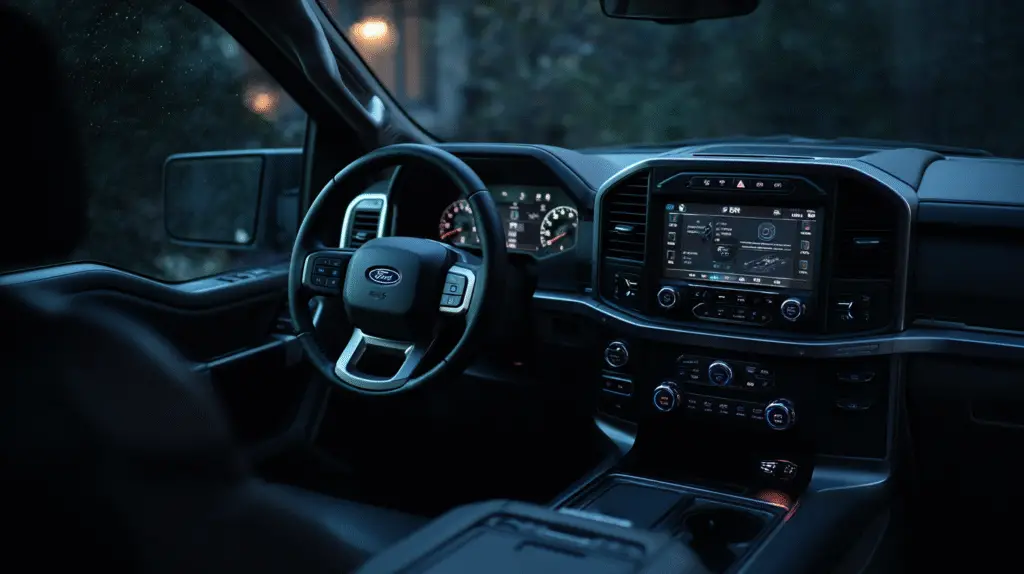Ford F‑150 Deep Sleep Mode is a battery-protection feature that temporarily disables non-essential systems to conserve power. It typically activates when the truck sits unused, the battery voltage is low, or in extreme temperatures. This guide explains when it triggers, how to exit it quickly, how to verify in FordPass, and what to do if it keeps coming back.
Key takeaways
- Deep Sleep activates with prolonged inactivity, low battery voltage, or extreme cold/heat.
- Exit the mode by starting the truck directly (not relying on remote start), then allow time for systems to reconnect.
- If it persists, load-test the battery, check for parasitic draw, and ask a dealer to update relevant modules (e.g., BCM).
- For storage beyond two weeks, use a battery maintainer and minimize parasitic loads.
What Is F‑150 Deep Sleep Mode?

Deep Sleep Mode is a battery conservation feature designed to protect your F‑150 when power is limited or the truck is inactive. When enabled, the vehicle reduces electrical consumption by disabling non-essential conveniences while keeping critical functions (security, immobilizer) available. It helps prevent unexpected battery drain so you can start the truck reliably after sitting.
What you’ll notice when it’s active:
- Remote features via FordPass may be limited or unavailable
- Some electrical systems feel sluggish or unresponsive
- You may see battery or power-related notifications
When Does Deep Sleep Mode Activate? (Criteria)

Deep Sleep can trigger under these common conditions:
- About 14 days of inactivity (truck parked and not driven)
- Low battery state of charge or voltage (e.g., significantly discharged)
- Extreme temperatures (very cold or very hot), which reduce battery performance
Note: Specific voltage thresholds can vary by model year and battery condition. Treat Deep Sleep as a protective response to prevent further discharge.
Signs Your F‑150 Is in Deep Sleep Mode

- Dashboard indicators: battery/power warnings or system messages about reduced functionality
- Unresponsive/sluggish electrical systems: windows, door locks, or ignition may respond slowly until power stabilizes
- Connectivity loss: FordPass may show “Vehicle Sleeping” or fail to deliver remote commands; the in-vehicle modem may power down to conserve energy
How to Wake Your F‑150 From Deep Sleep Mode
Follow these steps to restore normal operation:
- Unlock and start the truck directly with the key or push-button
- Remote start may not fully exit Deep Sleep and may not allow shifting into gear
- Let the engine idle for a few minutes, then drive 20–60 minutes to recharge
- Prefer steady driving; minimize electrical accessories (heated seats, HVAC, high-power charging) initially
- After starting, wait ~20–30 seconds for the modem to reinitialize before checking FordPass
If the truck doesn’t crank:
- Use a jump starter or compatible charger to bring the battery up to a safe level
- Inspect battery terminals for corrosion and ensure tight connections
Verify in FordPass After Waking the Truck
- Open FordPass and check Vehicle Status after waiting ~20–30 seconds post-start
- If it still shows “Vehicle Sleeping,” lock/unlock the truck and refresh the app
- If remote features remain unavailable after a proper drive, try signing out/in of FordPass and recheck
Preventing Deep Sleep Mode
To reduce the likelihood of Deep Sleep:
- Drive the truck regularly or use a smart battery maintainer (1–2A) if parked >2 weeks
- Avoid leaving accessories connected that draw power (OBD dongles, dash cams) when parked
- Park in moderate temperatures when possible; extreme cold/heat accelerates discharge
- Turn off high-draw accessories before shutting down
Troubleshooting If Deep Sleep Persists
If Deep Sleep returns quickly or remote features remain unavailable:
- Load-test the battery
- Even if it “starts,” a weak battery may drop voltage rapidly; recharge or replace if it fails a load test
- Check parasitic draw
- After lock/sleep, measure current draw; excessive milliamps indicate a module/accessory staying awake
- Inspect aftermarket accessories
- Remove or rewire devices that keep the bus awake (alarms, trackers, OBD devices, hardwired cameras)
- Ask the dealer to check software updates
- Request inspection of modules that manage power and connectivity (e.g., Body Control Module/BCM)
- Dealers can determine if applicable service messages/bulletins apply to your build
- Verify grounds and connections
- Poor grounds or loose terminals can cause intermittent power and false Deep Sleep triggers
Frequently Asked Questions
- What is Ford F‑150’s Deep Sleep Mode?
- A protective power-saving state that limits non-essential systems to preserve battery and ensure starting capability.
- How long does it take to activate?
- Often around 14 days of inactivity; can occur sooner with low battery or extreme temperatures.
- Can remote start wake the truck?
- Remote start may not fully exit Deep Sleep and may not allow shifting. Start the truck directly.
- How can I tell if my truck is in Deep Sleep?
- FordPass shows “Vehicle Sleeping,” remote features fail, and some electrical systems are sluggish; you may see battery-related warnings.
- How do I get out of it quickly?
- Start the truck directly, idle briefly, then drive 20–60 minutes; minimize electrical loads initially; wait 20–30 seconds for FordPass to reconnect.
- How can I prevent it?
- Use a battery maintainer for long parking periods, reduce parasitic loads, and keep the truck in moderate temperatures.
- What if it keeps happening?
- Load-test or replace the battery, check for parasitic draw, verify accessories, and consult a dealer for module updates and diagnostics.
Conclusion
Deep Sleep Mode protects your F‑150’s battery when it’s parked, the battery is weak, or temperatures are extreme. To exit, start the truck directly and allow time for systems to reconnect, then drive to recharge. If the issue repeats, focus on battery health, parasitic draw, and software updates. For longer storage, use a maintainer and minimize power drains to keep your truck ready to go.
Related Posts:
